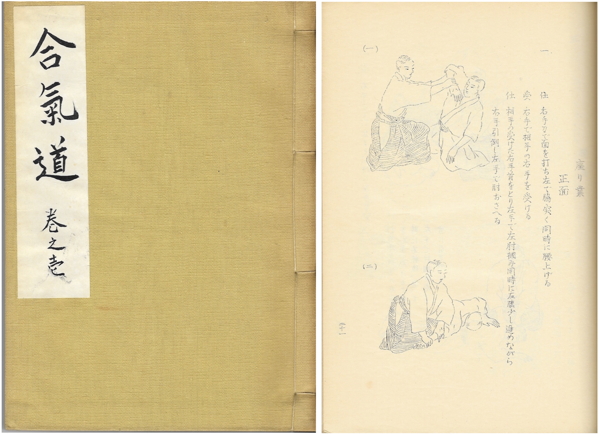
The cover of “Aikido Maki-no-Ichi” (1954) and the first page of the technical explanations
This page is identical to the first page of “Budo Renshu” (1933)
The 1933 training manual “Budo Renshu” (published in English under the name “Budo Training in Aikido“) was initially given to the students of Aikido Founder Morihei Ueshiba as a kind of a teaching license. It was hand illustrated by Takako Kunigoshi, a student at Morihei Ueshiba’s Kobukan Dojo who began training shortly before her graduation from Japan Women’s Fine Arts University. This was also discussed in the article “Three Doka and the Aiki O-Kami“.
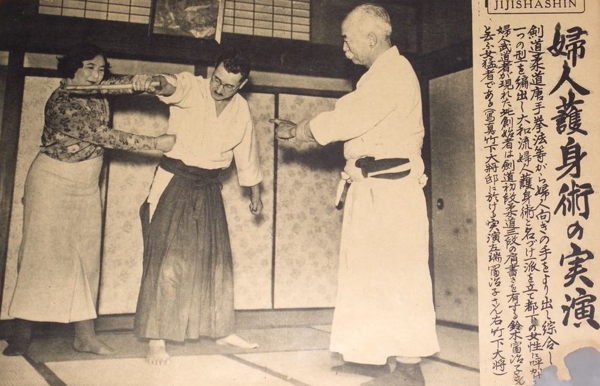
Women’s self-defense demonstration.
Fujiko Suzuki (鈴木富治子 or 富士子), founder of Yamato Goshinjutsu (大和流護身術)、 left
Sokaku Takeda and Morihei Ueshiba student Admiral Isamu Takeshita on the right.
The book “Yamato Ryu Goshinjutsu” was published in 1937 and illustrated by Takako Kunigoshi.
In 1938 Morihei Ueshiba privately published another book, a technical manual called “Budo”, for Prince Tsunenori Kaya, who was one of his students at the time. This manual was (re) discovered entirely by chance by Aikido Journal editor Stanley Pranin during an interview with Zenzaburo Akazawa.
A loose translation of “Budo” was published in English under the name “Budo: Teachings of the Founder of Aikido” by John Stevens. There is also a commentary by Morihiro Saito published under the name “Budo: Commentary on the 1938 Training Manual of Morihei Ueshiba“. Oddly, “Budo” has never been published in Japanese (with the exception that the Morihiro Saito commentary contains both Japanese and English).
I’ve discussed parts of this book before, in articles such as “Morihei Ueshiba, Budo and Kamae” and the following parts two and three.
In 1954 a book called “Aikido Maki-no-Ichi” was privately published by the Aikikai Foundation – this book was mentioned by Aikido 10th Dan Michio Hikitsuchi during the course of this interview:
Is our current style of practice different from that when you started?
Yes, the waza were done differently. You know, the other day I pulled out a book, Maki-no-Uchi. That was O-Sensei’s first book. We practised along the lines described in Maki-no-Uchi. ‘
Did O-Sensei distribute that book?
No. To have it, you had to have O-Sensei’s permission. For me, that was when I reached what would now be called shodan.
Was it a secret book, something that was never shown around?
Well, I don’t know whether I would call it “secret”. It was, after aIl, a book, and there probably are people who can learn just by reading. But it would have been very hard for someone to read the book end understand what it was about unless that person were practising Aikido. Unless you were shodan or higher, you wouldn’t know what to make of it. I think that is still true today. It’s not as if you can tell someone, “Here, do it as the book shows.” Aikido is something that becomes a part of you – something that comes through the spiritual training [shugyo] of physical practice [keiko].
Now, you don’t have to be too sharp to note that Aikido Maki-no-Ichi was not Morihei Ueshiba’s first book, since it was preceded by (at least) both “Budo Renshu” and “Budo”, but it is the first book by the Founder that contains “Aikido” in the title and was published after World War II and the formal adoption of the name “Aikido” for Morihei Ueshiba’s art.
So what is it? This book was privately published and distributed in 1954 by the Aikikai Foundation in mimeographed bound format, and was edited by Koetsu Ueshiba (Ni-Dai Doshu Kisshomaru Ueshiba’s birth name).
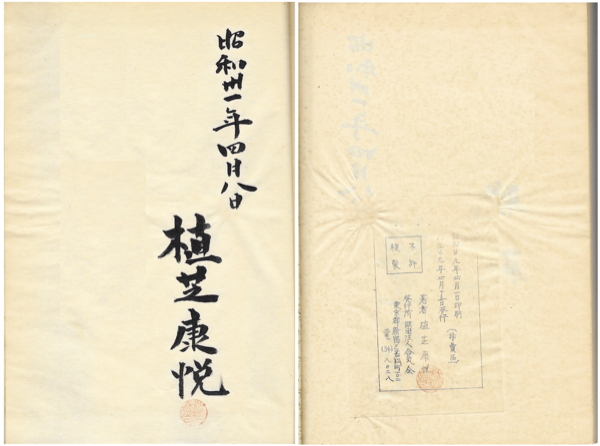 The back pages of Aikido Maki-no-Ichi
The back pages of Aikido Maki-no-Ichi
On the left – the signature of Koetsu Ueshiba, dated April 8th Showa 31 (1956)
On the right – published April 1st of Showa 29 (1954) by the Aikikai Foundation
and authored by Koetsu Ueshiba, Wakamatsu-cho, Shinjuku-ku, Tokyo
The material will be familiar to you if you are already familiar with Morihei Ueshiba’s pre-war publications. The text is mostly a combination of text from both “Budo Renshu” and “Budo” (cleansed of most of the pre-war imperial language), with the bulk of the book (which totals some 150 pages) consisting primarily of hand illustrated techniques from “Budo Renshu”.
Why does this matter, except as a curiosity? Well, this work is significant because it shows that what Morihei Ueshiba was teaching in 1954 was the same as what he was teaching in 1933. That five years after he told Morihiro Saito in Iwama that he had “completed” Aikido…he was still distributing the same material, containing the same explanations and the same techniques that had given his students in 1933 – when they were firmly students of Daito-ryu Aiki-jujutsu.
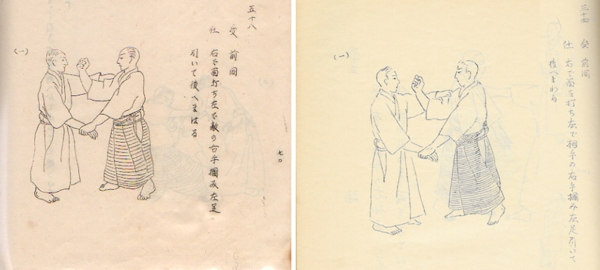 Atemi
Atemi
“Budo Renshu”, 1933 on the left / “Aikido Maki-no-Ichi“, 1954 on the right
In other words, the idea of a radical phase change in the technical core of Aikido after the war that is so commonly accepted…never happened.
This supports what Yasuo Kobayashi said about what he practiced during the early 1950’s at Aikikai Hombu Dojo in Tokyo:
Moderator: There were two books published before the war, “Budo” and “Budo Renshu”, was it only those techniques?
Kobayashi: Yes, that’s right. Of course, we did not do staff (jo) or sword (ken).
There is a discussion of this issue in “The Ueshiba Legacy, by Mark Murray” which you may like to read if you find this issue interesting.
This won’t be news to everybody, of course, Morihiro Saito used to carry a copy of the 1938 technical manual “Budo” with him while he was teaching so that he could show people that what O-Sensei had taught him in Iwama after the war most closely resembled what was represented in that manual published before the war, and not necessarily what was commonly being taught in other places.
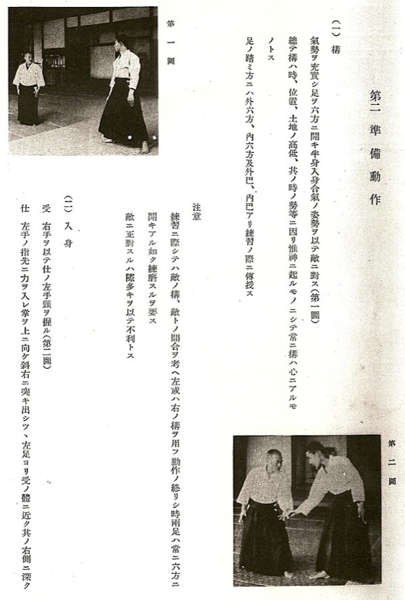
Aikido Founder Morihei Ueshiba demonstrates Kamae in “Budo”, 1938
“In footwork there is an external six directions and an internal six directions as well as an outer spiral and an internal spiral, this will be taught in practice.”
– From “Morihei Ueshiba, Budo and Kamae“
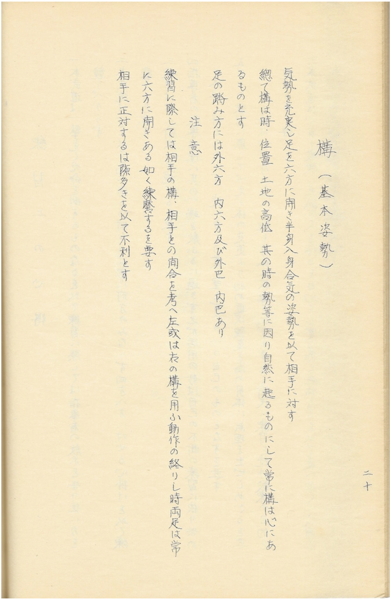 The identical instructions appear in the Kamae section of “Aikido Maki-no-Ichi”, 1954
The identical instructions appear in the Kamae section of “Aikido Maki-no-Ichi”, 1954
What is news is that, for the first time, this 1954 work presents hard evidence that what Aikido Founder Morihei Ueshiba was teaching and distributing after the war in the 1950’s was essentially the same material that he was teaching and distributing before the war. That, while some things changed, of course, there was no phase shift in core technology, or radical invention of new martial technology.
We also have this very interesting study by John Driscoll, originally published on AikiWeb, the almost exact correlation between the techniques taught by Morihei Ueshiba and the techniques of the Daito-ryu Hiden Mokuroku shows the continuing technical links between the two arts.
And this good visual comparison of the pre-war and post-war technique of Morihei Ueshiba that illustrates this point quite clearly:
So..how did “Aikido Maki-no-Ichi” come to see the light of day (and the light of the internet!)?
Last year I was talking to Scott Burke, who lives in Fukuoka, but often comes to Hawaii to join the Sangenkai workshops with Dan Harden.
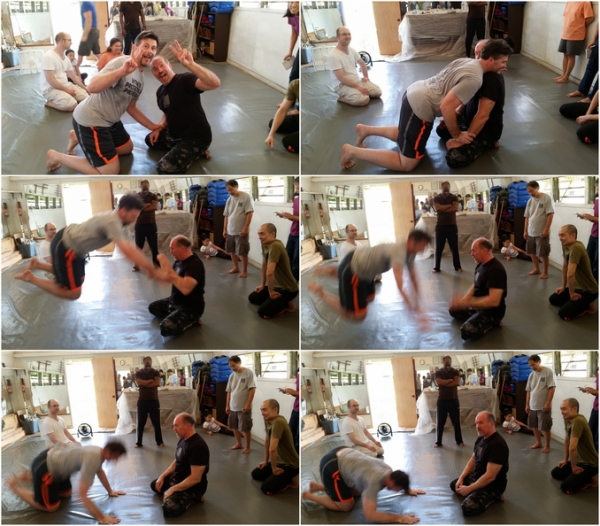
Scott Burke, left, in Hawaii – December 2013
Aiki-age at the Sangenkai workshop with Dan Harden
We got to talking about how riffling through old library archives led me to what I believe to be the oldest recorded interview with Morihei Ueshiba – the one contained in the article “A Leap of the Spirit – Moritaka (Morihei) Ueshiba in 1932“.
We talked about doing more of that kind of research (easier for Scott, since he’s actually in Japan), and Dan Harden encouraged the idea enthusiastically.
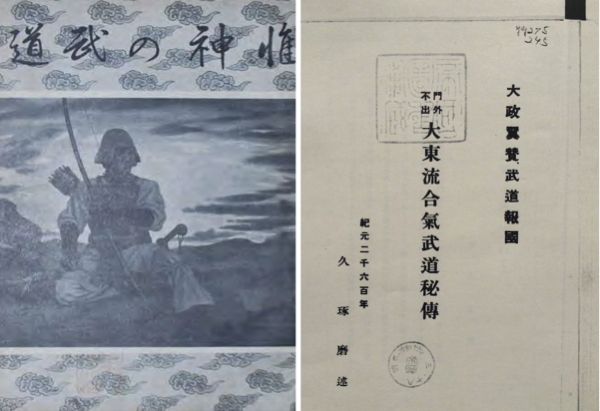 “Kannagara no Budo – Daito-ryu Aiki Budo Hiden”, by Takuma Hisa – 1942
“Kannagara no Budo – Daito-ryu Aiki Budo Hiden”, by Takuma Hisa – 1942
After returning to Japan he started frequenting the prefectural library and accessing the university library catalogs, and things started moving. In addition to things like “Kannagara no Budo – Daito-ryu Aiki Budo Hiden”, published in 1942 by Takuma Hisa (which he published about Daito-ryu, as a menkyo kaiden in the art, but duplicates large sections of the text in “Budo Renshu” and “Budo”), he also came across….”Aikido Maki-no-Ichi”.
And now you have too – here is the 150 page complete scanned edition of “Aikido Maki-no-ichi” in PDF format. Published in 1954 and edited by Koetsu Ueshiba. There is only one alteration, the name to whom this particular volume was dedicated has been omitted for reasons of personal privacy.
- Download (Dropbox) “Aikido Maki-no-Ichi” (PDF format / 14 MB)
- Download (Aikido Sangenkai server) “Aikido Maki-no-Ichi” (PDF format / 14 MB)
Enjoy!
Published by: Christopher Li – Honolulu, HI
All of the content on this site is, and will continue to be, provided free of charge as a service to the community. You can help support this project by contributing a little bit to help support our efforts. Every donation (even $1) is greatly appreciated and helps to cover our server and bandwidth costs, and the time involved. The more support that we get the more interesting new content we can get out there!
By donating you also help support our efforts at Aikido Hawaii, which has provided a state-wide resource for all Aikido in Hawaii, regardless of style or affiliation, for almost twenty years.
Thank you for your support and encouragement,
Chris

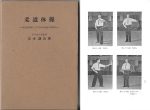
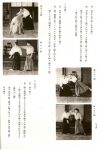



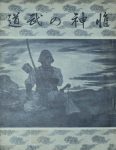
Thanks Chris Li, for the details of the history of Maki-no-Ichi. Michio Hikitsuchi Sensei republished it in Shingu in the 1970’s, and many of his students (including me) bought a copy then. Fascinating book. – Linda Holiday
Thanks Linda – I agree, very interesting material!
Best,
Chris
What a treat! This is a fantastic find Chris and it makes total sense when looking at it in comparison to the Takumakai curriculum with which I am somewhat familiar. Interestingly, I was planning to teach some techniques off Budo Renshu (I only own the French translation, which has odd things in it) during my summer courses, this copy will be a great teaching aid! Thanks a lot for sharin this Chris!
Thanks Guillaume! We were very lucky to find it – it’s surprising how many things are still floating around out there waiting to be found.
Best,
Chris
One more great article by Chris. I always wanted to have a look at “Aikido Maki-no-ichi” , since it seemed to be some forgotten and rare book by the founder. But now, thanks to Chris, we all can see, that this is a combination of text from both “Budo Renshu” and “Budo”, not only that, as i was going through the book, i have noticed interesting thing, several technical sequences from the “Budo” were hand drawn to match the contents taken from “Budo Renshu”. In any case, what is fascinating is the fact, that this book was published in 1954, when the founder supposedly was teaching the new, postwar aikido, and yet it was approved and published by O sensei, with all the prewar content in it. This is certainly one more hard evidence, just as my comparison of the pre-war and post-war technique video. Speaking of it, there is some sound problems with it Chris, please consider re-uploading it from my channel.
Thanks Marius! And than you for creating that wonderful video comparison of the Founder’s technique!
Best,
Chris
By this article, you give an answer to a question I had in mind. Thank you very much.
Andre Nocquet stated in an interview that he was given by O Sensei a book containing some drawings of techniques. I thaught about Budo Renshu, but this seemed strange to me, given the fact that Budo Renshu was an old prewar book, with very few copies remaining postwar.
Now it seems more realistic that the book given to Nocquet Sensei was “Aikido Maki no Ichi”.
Best,
Damien
Seems likely, Andre Nocquet was there right around the time the book was being distributed!
Best,
Chris
I want to add a few points that are seldom made:
1) teaching of Aikido didn’t resume directly after the war. In 1954 when Kishomaru Ueshiba re-published the book, the Kobukan dojo / Honbu Dojo was still not a regular operation. There’s a reason, Gozo Shioda not only founded his own dojo, but was also able to attract several high-ranked people to join his operation. So, whatever Kisshomaru published in 1954 is not representative of what was taught in Hombu when it actually became a full time school again.
2) The Wakamatsu-cho dojo / Honbu dojo was handled by Kisshomaru Ueshiba, and his influence on the art seems to be what makes for the pre-war / post-war distinction. Add to that that Tohei sensei was chief instructor for several years and he put a lot of effort into devising a rational way of teaching efficient techniques (which is overlaid with his Ki religion, but from what I’ve seen, his explanation of technique and the exercises he devised are very rational), and you got an explanation where the differences come from.
3) likewise current Aikikai shihan are taking the art to new places: look e.g. at what Yasuno sensei is doing. This is not what O Sensei was doing, this isn’t what Kisshomaru or Tohei were doing, it’s beautiful and it has the same roots, but people who divide Aikido into pre- and post-war, should also acknowledge that there is at least one further overhaul
4) there are differences in Saito sensei’s teaching from pre-war Aikido. For instance in Shomen Uchi Nikyo: if you look at the 1935 movie you will see O Sensei apply the technique in the way it’s still done at Yoshinkan dojos: Uke’s hand doesn’t touch Shite’s chest during the lock. Saito sensei taught to move uke’s hand against the shoulder when doing the lock, just like you see O Sensei do in some post-war videos. I will admit though that it’s kinda silly to say that O Sensei or Saito sensei only taught one way of doing the technique. But for that same reason, I always thought it was a bit disingenious by Saito sensei to say “this is the way O sensei taught the technique, and it’s the way I’m teaching it.” I’m always wondering if he wasn’t encouraged a bit too much by Pranin, who after all claimed Saito as his rediscovery of the original Aikido.
I started writing a long paragraph about the naming of techniques (why are some techniques Ikkajo in Yoshinkan but Nikyo in the Aikikai etc), but the more I put it into words, the more complicated it became, so I will spare you that. Let me just say that I doubt that O Sensei ever called them Ikkyo, Nikyo etc or used a fixed scheme — anyway, I don’t think it matters.
A couple of comments:
1) There had been training at the Hombu dojo going on from as early as 1948, but only in small groups. The roof had fallen in and there were refugees living in the dojo – but training was going on there for a number of years prior to the book being published. More importantly, Morihei Ueshiba was teaching in Iwama during that entire time (Morihiro Saito started training in 1946). Gozo Shioda made a splash at a public demonstration held by the Life Extension Foundation in 1954 and attracted some wealthy backers, then started out on his own – for a number of reasons.
Of course the book is not representative of what was generally taught in Hombu after 1955 – that’s the point, that they changed what Morihei Ueshiba had been teaching.
2) Of course, the differences came mainly from Kisshomaru Ueshiba and Koichi Tohei – not from Morihei Ueshiba as is usually alleged.
3) Many people take things in their own direction, and there’s nothing wrong with that, my argument is with the post-war Aikikai storyline that Morihei Ueshiba himself altered the core technology when the changes were actually implemented by Kisshomaru and Koichi Tohei.
4) Certainly, Morihiro Saito made changes as time went on – he even said so himself. So did Morihei Ueshiba, so does anyone who trains over a number of years. The question, to my mind, is whether or not there were changes made to the core technologies by Morihei Ueshiba, and this book supports the argument that there were not.
Best,
Chris
Sorry about the delay in response, I had some computer mishap in the meantime and only now do I have time to follow up. It sounds like our research has lead to similar results about the story of pre-war and post-war aikido.
Researching a quote that I had in mind when I wrote my previous post, I see that my view of history was slightly inaccurate, and it’s closer to what you are saying in your response to point 1. Namely, my assessment of the situation in 1954 was based on what Shioda sensei told Black Belt magazine, to wit: “I don’t really feel that I broke away from the mainstream of aikido since there was nothing to break away from back then. Uyeshiba sensei (the late Morihei Uyeshiba, founder of aikido) was farming, his son Kisshomaru was working for some company, and sensei’s aikido dojo at Iwama in Ibaragi Prefecture was being rented out as a dance hall.” Seeing it again in context, Shioda was busy teaching and using the term “Yoshinkan Aikido” already around 1950, and therefore this quote may refers to a time long before the establishment of the Yoshinkan dojo in 1955. So I was not justified in assuming that regular operations hadn’t picked up again in Wakamatsu-cho when Kisshomaru Ueshiba published the manual in 1954. It still remains the question why a number of high-ranked students, Terada is the first that comes to mind, joined the Yoshinkan, but I digress.
It definitely makes sense that K. would publish the book when there were some students who would be interested in having some kind of manual.
I will also relate three things that two Yoshinkan shihan, both former Uchi Deshi to Shioda sensei, told me about the history of post-war aikido (I don’t know if these are their own thoughts, or whether they heard this from Shioda sensei, all this happened well before their time, and is thus to be taken with a large grain of salt):
1) Ueshiba Kisshomaru was smart. He wanted the art to spread, so he aimed for universities. In order to make it attractive, he made it softer, more gentle.
2) he changed the names from Ikkajo to Ikkyo etc to emphasize that it’s no longer Daito Ryu, and thus something more accessible
3) (related insofar as it adds some interesting light on aikido’s development) around the time when Tohei sensei was ousted by the Aikikai, he approached Shioda about joining the Yoshinkan. He felt that the Yoshinkan’s aikido was closer to what he was doing than what they were doing at the Aikikai.
Hi Tobi,
1) You’re right about the universities. The Aikikai built up a huge network of university dojo in Japan that paid off when the students went on to become working people.
2) The names certainly changed, I’m less certain about the reasons since Ikkajo and Ikkyo are really different things in Daito-ryu and Aikido, although you may be right about his efforts to distance the two.
3) Is very interesting, I’d never heard that before!
Thanks for the input!
Best,
Chris
Thanks again for the thoughtful response. Concerning point 3 I will emphasize that I put this behind a few caveats, but it’s definitely an interesting story 🙂
About the names: as you certainly know, the usage of ikkyo vs ikkajo is not universal in Aikido: Yoshinkan uses ikkajo. Isoyama sensei also claims that O Sensei was “still” using Ikkajo et al. when he started doing Aikido. In other words, that classification alreay existed at that time and probably before the war. There are some minor differences between the Yoshinkan and the Aikikai, but nothing that makes me believe that they don’t have the same origin. As I understand it, the difference with Daito Ryu comes about because Takeda Sokaku wasn’t about classification at all, and it was only his son who organized the techniques, long after Aikido had started using their ikkajo, nikajo etc.
It is also interesting to note that Tomiki groups seem to use descriptive names (ude osae, ude mawashi, ude hineri, and tekubi osae IIRC). By itself this is not surprising and fits well with Tomiki sensei’s background in Judo and Kano’s pedagogy. But these descriptive names are also given in the instructional video by Kisshomaru that you can find on youtube (in addition the Ikkyo, Nikyo etc names). Of course, the reason for this could be something as trivial as that the English language screens were created by a Tomiki aikidoka. Actually, if you watch that black and white Yoshinkan movie from the 60ies, the techniques are also not named e.g. nikajo but gyaku te osae (or something in that vein), so the history of naming may be even more complicated — or they chose to be a bit more descriptive for that movie, and the naming there means nothing at all.
Hi Chris,
I think a point made by Peter Goldsbury, Stanley Pranin, Ellis Amdur and others bears mentioning: up until the 1950s, aikido was a CLOSED martial art that was only taught to a select few members of Japan’s prewar elite society. It was essentially an art like Katori Shinto Ryu, but afterwards its development paralleled that of Shotokan Karate and spread through the university system and business community. That’s a MASSIVE change and I think more than the prewar/postwar dichotomy is responsible for much of the technical development of the art as well as the personalities involved in its dissemination. Great stuff! BTW can I get your email? Wanted to ask you a few things. Jya!
I agree, and it’s important to remember that Morihei Ueshiba was not the Ueshiba behind the public rollout – that was all Kisshomaru.
I’ll shoot you an email.
Best,
Chris
Chris, like others thank you for providing this and other resources on your site.
Going through in some more detail I see that pages 133-134 are missing from the scan. Yet technique 86 has its four steps on pages 131-132. Technique 87 then starts on page 135.
Do you know or can you check with Scott whether these two pages were missed or if the original had the last three page numbers wrong? Curiosity has the better of me.
Thanks,
Craig.
Hi Craig,
Sharp eyes! The technique numbers line up correctly, so I think that it’s rather a numbering error for the page numbers.
Best,
Chris
Thanks Chris. I agree that’s a likely explanation.
Thank you for another great article. I was wondering if there are other record of women practicing aikido in the early times besides Kunigoshi, and when did women number started to grow on the dojos. Besides, did Ms. Fujiko Suzuki practice Aikido also?
I think that Fujiko Suzuki probably trained with Morihei Ueshiba as well. And of course Shigenobu Okumura mentions that Noriaki Inoue taught a women’s self defense class here:
https://www.aikidosangenkai.org/blog/interview-aikido-shihan-shigenobu-okumura-part-1/
Best,
Chris
John Driscoll’s wonderful two essays on the correspondence of the techniques of Daito-ryu and aikido, and the probably roots of aikido’s koshinage (alone) from Goto-ha Yagyu Shingan-ryu, have been combined, revised, illustrated and republished here http://kogenbudo.org/reflections-on-the-origin-of-ueshiba-moriheis-koshinage-the-relationship-of-daito-ryu-and-aikido-waza/
Thanks for the link Ellis!
Best,
Chris
so generous post, i am impressed. Thank you.
hi Chris,
I am studying in Japan right now and would like to ask you , or if you can contact me with Scott Burke, about this material. I have been searching for it but cannot get any information in japanese, even the research papers on aikido show nothing about it. I was wondering how did Scott got to this and if the material can be accessed in person.
Thank you so much in advance!
Hi Camila,
Message me privately, I’ll put you in touch with Scott. There’s quite a lot of material online at the National Diet Library (https://dl.ndl.go.jp/). Your local library can actually order materials for you that aren’t yet digitized, and most of that is indexed online. Online auction sites can also turn up some interesting things from time to time.
Best,
Chris
Hi Chris,
Thanks for your prompt reply!
It would be great if Scott Burke could help me about this, I have searched in the National Diet Library but nothing comes out for 合気道巻之壹、perhaps I might be failing in the search criteria …
Should I write to you to this address? wordpress@aikidosangenkai.org
Thanks again, best regards!
HI Camila,
I got your email from the comment – I’ll send it along to him.
Best,
Chris
Hi
Looks an amazing book is it possible to buy it nowadays and if so how much, where from ?
Many thanks
Colin